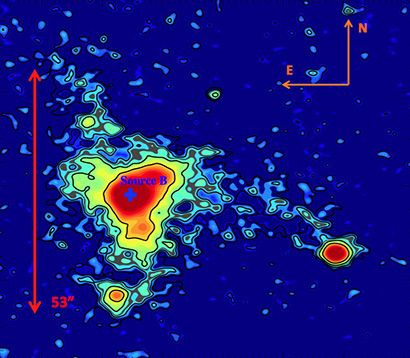What’s Powering MAMMOTH-1? Glowing Nebula In The Heart Of Ancient Galaxy Protocluster Baffles Astronomers

Nearly 10 billion light-years from Earth lies a structure that has left astronomers baffled. The blob of gas, named MAMMOTH-1, is glowing brightly, even though there is no discernable source illuminating it.
MAMMOTH-1 is a nebula that lies in an overdense protocluster of ancient galaxies. It belongs to a class of objects known as enormous Lyman-alpha nebulae (ELAN), which shine brightly in the Lyman-alpha line associated with hydrogen gas that has been heated up by the ultraviolet emissions of newly-formed stars.
The first ELAN, discovered in 2014, was named the Slug Nebula, and scientists believe that it — as well as most other ELANs detected since then — is emitting Lyman-alpha radiation as a result of being illuminated by intense radiation from quasars.
Quasar — a quasi-stellar radio source — is a compact region surrounding a galaxy’s supermassive black hole, heated to such an extent that it emits massive amounts of energy and can even outshine the galaxy in which it resides.
MAMMOTH-1 (named after the survey that detected it — Mapping the Most Massive Overdensities Through Hydrogen), however, is the first ELAN not associated with a visible quasar.
“It's extremely bright, and it's probably larger than the Slug Nebula, but there's nothing else visible except the faint smudge of a galaxy. So it's a terrifically energetic phenomenon without an obvious power source,” J. Xavier Prochaska, a professor of astronomy and astrophysics at the University of California, Santa Cruz, who was part of the team that discovered the nebula, said in a statement.
So what exactly is powering the Lyman-alpha emissions from MAMMOTH-1?
One possible explanation, outlined in a study accepted for publication in the Astrophysical Journal, could be outflows from an active galactic nucleus (AGN) — which is itself being powered by a supermassive black hole. The AGN, of which the quasar can be a part, may be so obscured by dust that only a faint source can be seen associated with the MAMMOTH-1 nebula.
Although there is strong evidence to suggest that a hidden AGN is energizing the nebula, it is yet to be seen in optical images.
“I expect there's a quasar that is so obscured by dust that most of its light is hidden,” Prochaska said in the statement.
Scientists believe that understanding the exact amount of Lyman-alpha photons emitted by galactic protoclusters and nebulae, and how this amount changes over time, is key to comprehending not only the evolution of galaxies and stars, but also to getting a clearer picture of the conditions prevalent when the universe was still young.
© Copyright IBTimes 2024. All rights reserved.






















